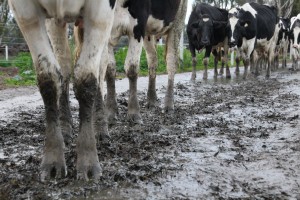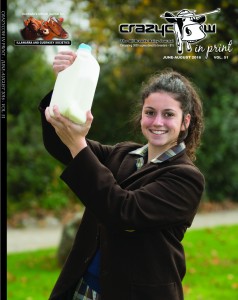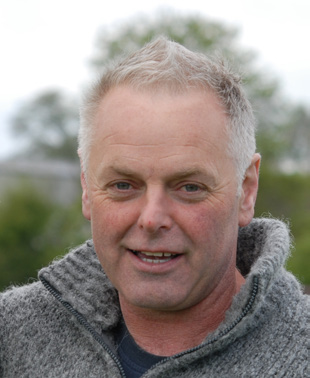Pat Conroy’s piercing blue eyes are as recognizable as his distinctive Minnesotan-born drawl – punctuated by the spit from some tobacco chew tucked securely inside his bottom lip.
Pat has earned his stripes in the industry at every level. And he’s at the top of his game.

Pat and Jeannie Conroy have two children, Kaiden and Zailey. The family call Angola, Indiana, USA, home.
When Pat’s not picking Champions, he’s usually leading them and/or owning them. He has fought for his position in the industry from nothing, using determination and competitiveness. Yet he carries himself nowadays with a quiet confidence and a certainty about where he fits in the industry. He is respected for his ability, honesty, and straight-shooting personality.
While he says he never wanted to judge – nor liked it initially – Pat allowed himself to be drawn into it for a reason. In August, he judged the Western New York Regional Show on the 18th, before flying to Brazil to judge at Agroleite five days later. Two days after that he landed in Australia to oversee the New South Wales State Holstein Show on August 25 and 26. His three days in Nowra was a long way from home, and his own preparations for WDE and The Royal Agricultural Winter Fair in Toronto, Canada.

Pat Conroy about to accept Grand Champion from WDE 2015 Holstein judge Nathan Thomas on behalf of Lovhill Goldwyn Katrysha. Pat led Katrysha for her owners MilkSource Genetics of Kaukauna, Wisconsin. That year Pat also judged WDE’s Red & White Holstein show. Photo: The Bullvine.
His 2016 judging résumé alone notably included the Holsteins at WDE, the Swiss Expo Holstein Show and the European National Show. In 2015 he judged WDE’s Red & White Holstein Show, and he was the 2013 WDE’s Junior Holstein Show judge.
Pat has also judged the 2014 All-American Jersey Show in Harrisburg, and the 2015 Brown Swiss Expo in Switzerland.
Boxed and loaded
Pat says when he left home, he had a box of Holstein World magazines, his clothes and little else.
He began cattle fitting aged 16, and by the time he was 19 was working every day of the year in his chosen profession. Pat’s career came at a time when there were a lot of talented fitters available in a busy industry, and he had to be hungry to succeed – let alone to just survive. For the next 16 years, preparing cattle for shows and sales ruled Pat’s life. It took him coast-to-coast in the USA, and into Canada, Mexico, Columbia, Argentina, Ecuador, Brazil, France, Germany, Switzerland, and Australia.
The competition and his passion kept him sharp.
“Fitting was something I always wanted to do. I always wanted to be around good cattle, and to have the opportunity to work with them. There was a good competition between us all at that time, and from the start, I always wanted to outdo the next guy.”
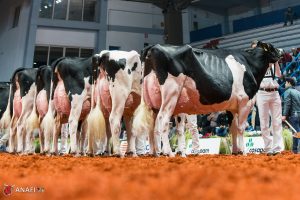
Pat owns 50 head of show cattle across North America and Europe. Pictured is one of them, Hallow Atwood Twizzle EX93-Max, the 2016 Grand Champion at Cremona, Italy. Pat owns her with All Nure and Gary Jones. Photo: The Bullvine.
Box cut
He pauses, before adding: “Wanting to win made you think. If you don’t have some competitiveness, you stay in neutral. Young guys today – and some won’t like hearing this, but it is true – all they want to do is clip, and that’s it.
“I’m finding that many young people don’t maybe know what a good one is supposed to look like, and so they cut them all in the same.
“Our industry has promoted a lot of bulls over the years that sired a lot of high-pinned heifers. Yet, I’ve seen a lot of fitters still leave big hair on those heifers’ chines – which just makes it worse. They don’t see that the logical thing is to mow her chine off to make her look a little more balanced.”
Skills clipped
“And, I’ll be honest with you – and probably the generation above me said this about us – hardly any of the current crop of fitters would have survived in our era. They don’t know how to work, and a lot of them aren’t good cow people. So, if a cow is sick, they don’t know what to do – they disappear like a flock of birds when the going gets tough. They’re just clippers, that’s it.
“They’ve been spoiled and spoon-fed because there’s a shortage of fitters. In our day, you had to be good or no-one hired you. Now, they can be busy every week. Everyone wants US$250 a day when they start working, and kids now all seem to need a safe place if someone says something they don’t like. What is that? My wife and I have robust discussions about this all the time – I think it’s important that kids learn how to work hard and take the knocks.”
He says intelligent hard-working fitters remain potential game-changers.
“Good clipping really does make a big difference on heifers – on cows, not so much. You can make a good heifer great by the way she’s prepared and managed – no question. Equally, you can make a great heifer middle of the road if you don’t get her preparation right.”
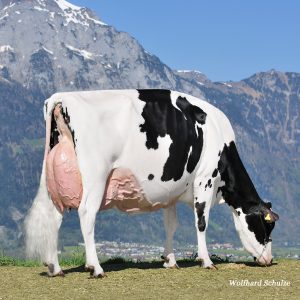
Decrausaz Iron O’Kalibra EX97 wowed the world. The thrice Swiss Expo Grand Champion was one of the few cows Pat Conroy chose stay with for her entire ride. Photos: Wolfhard Schulz.
Fitting into ownership
As he grew into his fitting career, Pat started to focus on building capital. He says it wasn’t hard to become addicted to buying cows – and he fearlessly backed himself. Decrausaz Iron O’Kalibra EX97 remains his personal pick.
Born September 4, 2008, O’Kalibra would go on to be the 2013 European Champion, thrice Grand Champion at the Swiss Expo (2012, 2013 and 2015) and the 2015 All-World Champion. She is Europe’s most famous cow, and the vibrations of her influence were also felt in Australia, when her Goldchip daughter sold for an Australasian record price of $112,000 in 2015.
Usually when he buys, Pat intends to sell them on. It’s the reality of a cattle marketer’s life. However, this time he chose to stay with O’Kalibra until the end, which came in May this year when she passed away.
O’Kalibra was bred by Fredy Decrausaz & Sons. Sired by Boss Iron, she was out of an EX90-2E Integrity daughter, followed by a VG89 Milestone. She had the width Pat loved, and a pedigree they could work with.
“O’Kalibra was just such a good doer and so aggressive. We had a lot of fun with her,” he says.
“She was game-changing for me and she was cheap in the end for what she did for us all. And she was special to me because this time I co-owned her all the way through. There’s been a lot I’ve sold through the years – and you love to see them do well for other guys – but once in a while, there’s one you want to keep.”
Throwing a fit…
He smiles as he remembers the day he first saw her, saying he experienced the feeling cowmen often describe when they see a cow they have to have. It is a moment when the world seems to stand still – when the hairs raise up on the back of their necks. And there’s absolutely no hesitation. They just know they need to be part of her journey.
Pat says if he wasn’t so determined he could have easily missed getting aboard the O’Kalibra train.
“They didn’t want to sell part of her at first,” he laughs. “I honestly threw a fit like a kid, because I was so mad. I did – I threw a fit until I got my way. She was one of those cows I had to have, for sure.”
Win some – lose some
Typically honest, Pat is quick to balance the glory with the risk.
“I’ve lost a lot of money too on cows too. There was four of us in a partnership and we paid US$160,000 for a cow. I thought she’d be a cow to be Champion at Madison [WDE] and the year I had in my mind she could do it, she died. I didn’t have insurance on her, and I was fairly young at the time so it was a fair kick in the teeth. It took a lot to rebound from that one because it kind of cleaned me out.
“Usually the first loss is the best one.
“I built back up, and I made another dumb decision. Three of us bought a nice cow for US$98,000 and a week later she got on the trailer and split her bag. That hurt too.”
He says buying and selling commercial cattle is a big part of his business today because the work is consistent and busy. The commercial cattle help him enjoy registered cattle. They also help underwrite his “addiction” to show cows.
Judgement day
His journey into judging evolved naturally. While he wasn’t interested, he did have strong opinions that weren’t always in line with popular thought. It is part of the reason he dons a suit more often than he’d perhaps like to.
“Somebody asked me to do a County Fair once and I said I’d do it, but it wasn’t a great experience. I thought to myself: ‘I’m never going to judge again’, but then I got asked again, and I did it and it ended up being a nice show. The biggest reason for me personally to start judging is that I got sick of narrow, high-pinned, bad-footed cows winning because they were black.
“For me, that was the biggest push. I thought somebody has got to step up and change this a bit. I think that maybe some guys who milk cows every day come to the show and they see those high-pinned, narrow cows winning and they make fun of the showing business. We’re supposed to have these high-type cattle, and to their eyes, those cattle are not functional.
“That seems to become negative publicity for the show industry. I’m not on Facebook, but I do watch the question of the week on Dairy Agenda, and I read the comments, and they’re always negative about the show industry. I want to do something to help change that for the breeders that don’t necessarily show.”
Playing favourites

Sheeknoll Durham Arrow becoming immortal at last year’s WDE when judge Pat Conroy made her Grand. She is led by her breeder/owner Jeannette Sheeham, from Sheeknoll Farms at Rochester, Minnesota, USA. Photo: The Bullvine.
That brings him to his favourite cow he has made Grand Champion to date: the 2016 WDE Grand Champion, Sheeknoll Durham Arrow. Bearing in mind, there were 2423 animals at Madison in 2016 – including 640 Holsteins (the biggest breed show) and WDE welcomed 74,000 visitors from 102 countries through its gates last year. There is always a massive audience ring-side for the Holstein judging, and the pressure resting on the sole person to award Grand should never be underestimated.
“I think because I grew up at WDE in Madison, it was the show,” Pat says. “Making that cow [Arrow] Grand was fun and a good experience. I didn’t make her Grand because she was a no-name cow before the show and I wanted to find a new Grand Champion, like some – no doubt – thought. She won it because she deserved it. It was just nice that the cow got ready on her own, she looked the part, and she was an easy fit that day.
“Madison was the easiest show to judge because you can find your kind and just go for it. At some of the other shows, you make cows Champion, that perhaps don’t excite you – but they’re the best ones there on the day. You play the cards you’re dealt.”
Heifers need width
He stays true to form on the type of show heifers that he believes will go on and make cows.
“Some people might bust my arse a bit for this, but I’ll take a heifer a little thicker, and I’m okay with that if they’re sound. The Quebec guys – and many of them are my friends – don’t like the style of cows I like. They’ll take them narrow and black.
“I’ve always liked the stronger ones, because if there ever a problem at any of the farms I’d be working at, the one that was sick and off her feed was always the narrow one. Always.
“And then I started taking care of my own heifers when I bought my first little place and I would have heifers in and that included the big black fancy ones I bought, and shouldn’t have. When I’d go to grain them and it was -60 [-15 degrees Celsius], the one standing in the corner sucking their thumb would always be the narrow one.
“So, personally I can’t stand skinny heifers. It makes their legs look bad and they don’t have any substance. Maybe the next guy could take them skinny, but not for me. Heifers need to have muscle tone – like an athlete.”
Give it a couple of years…
Pat says patience is a virtue in the judging game.
“I always remember what they say if they’re unhappy with how I place them, and then I’ll wait a couple of years and have the conversation again. Not that I’m always right, by any means, but it’s interesting to see which of those animals last, develop and breed back,” he smiles.
The eternal question the industry has wrestled with has been the term “dairy strength”, and because it is subjective, it has proven to be an oft-confusing conversation.
“That’s another thing that pushed me into judging,” Pat says. “People have the assumption that ‘skinny’ is ‘dairy’. It’s not the case.” He says there’s a huge difference between “dairy strength” and being “half starved”.
“I think if the people making those calls had to write a cheque for one, milk them every day and calve them down, they’d learn quite a bit that way – and that includes the AI guys who don’t own or work with cattle, but who have had a role to play in starting this narrow high pins dairy, dairy, dairy crusade.”
Progress going backwards?
The impact of genomics and changing dynamics continues to be a concern when it comes to the future of shows, says Pat.
“I don’t want to be negative, and say there won’t be many shows in 10 to 15 years, but I’m afraid that might be the truth. I know how much it’s changed in the last 20 years, and I wonder where it will be in 20 more years.”
Pat says if he could use a time machine to choose his time to be involved in the industry, he would take the late 1980s and early 1990s.
“I’m certainly grateful for my career so far, but I almost would have loved to have been that earlier era when it was very competitive, and there was lots of investors,” Pat said.
“There were no cell phones, and no internet – it was exciting. Once in a while I grab one of my old Holstein Worlds and look through them, and it’s kinda depressing because we’re never going to have that again. It’s almost like the party’s over a little bit. I don’t know how we’ll ever get it back.”
Madison whispers
Pat confirms that this year’s lead-up to WDE in October is not rife with the usual energy and excitement that comes with cows changing hands for big money. The game has changed, and most marketers’ inventories remained available for sale when CrazyCow went to print.
“Certainly with the milk price we’ve lost a lot of good breeders and I think there’s just a bit of a negative atmosphere because of that,” Pat says. “The top-tier buyers that I would normally be selling to are disappearing. And so, the ones that are left aren’t faced with as much buying competition for animals.
“It used to be that you’d get a lot sold before the show because potential buyers knew if they looked at an animal one day and liked her, they better buy her because there’d be someone else coming to look at her the next day.
“At Madison, I think the final-tier guys will buy there, but they don’t have to be in a hurry right now because they know that the guys like me that are selling have ultimately got to sell them – that’s our business – and there’s only limited competition, so they’re going to be patient.”
Comical source
It’s a long way from the days when Milk Source, Butlerview, Arethusa, Gene Iager, West Coast, Gerald Todd, Howard Binder Jr and Clark Woodmansee (to name a few) were all competing strongly.
By the time everyone converges on the showgrounds at Madison, Pat says animals will then be compared with others on-ground – everyone will have an opinion – and the white noise will be distracting for buyers trying to make decisions.
“I think it’ll be so cut throat this year, and there’ll be a fair bit of back stabbing. It will be quite comical, I bet,” he smiles.
“And, some of that attitude can also be attributed, I think, to people who are doing a helluva good job at shows and when others know they can’t compete with them, they are starting to say: ‘Why go?’.”
In Wisconsin, that’s getting fairly evident because Milk Source and Budjon – to cite just two – are doing great jobs and it’s expensive to show and if you don’t want to sell an animal it makes it harder to pay for it all.”
Shrinking industry heightens ‘tall poppy’
He says the shrinking industry is heightening the tall poppy syndrome and jealousy within the US registered industry.
And he doesn’t back away from it.
“Shit, I almost feed off it a little bit. It’s like a pack of wolves in a pen. If you throw enough meat in there, it’s fine. If there isn’t enough meat, it gets pretty fierce. And the dairy industry is at that same point in the US, I think. There are a lot of wolves and not a lot of meat.
“Sometimes, I think I wouldn’t care if I never went to another show again, but the truth is I’ll never quit. I get too psyched about it.
“I said I wasn’t going to buy a thing for the rest of the year, and I bought a heifer a couple of weeks ago, and I’ll buy one at Madison too. I know I will.”
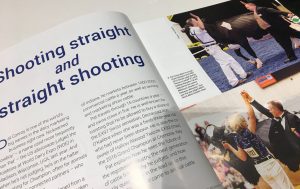
Be sure to check full coverage of this week’s Le Supreme Latier where Pat will be serving as the official Holstein show judge.
Get original “Bullvine” content sent straight to your email inbox for free.
Other posts you might like:






